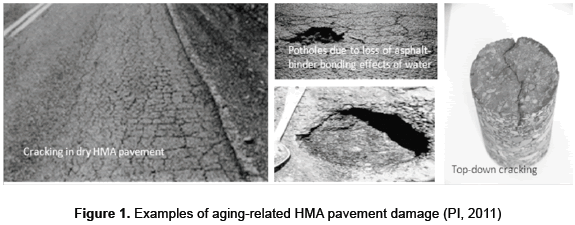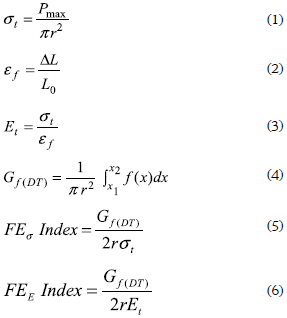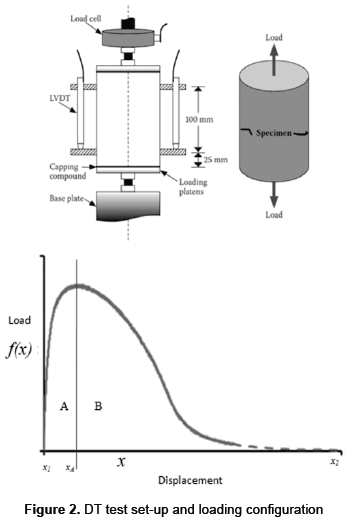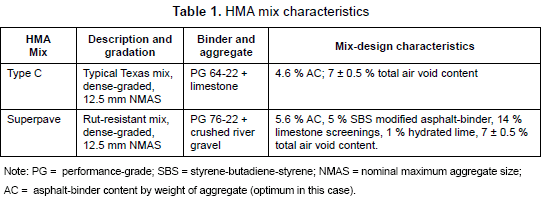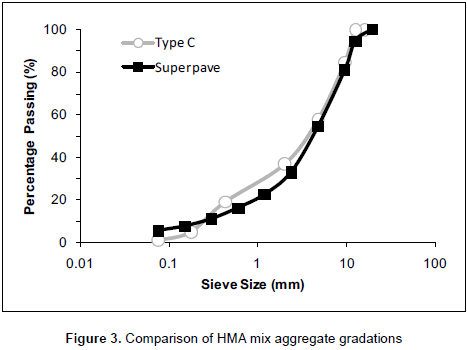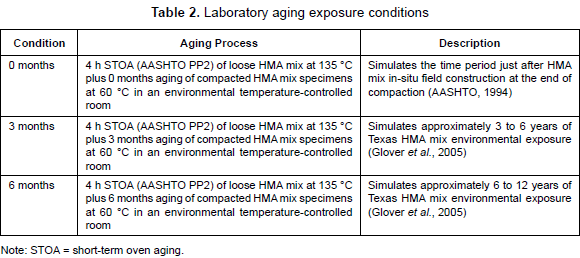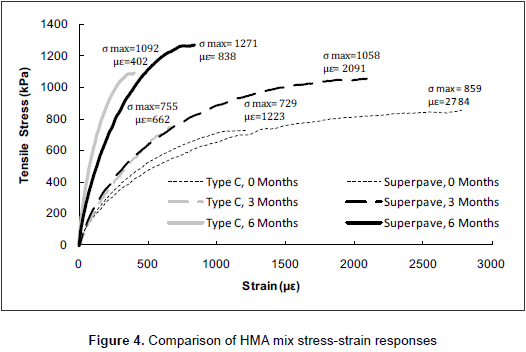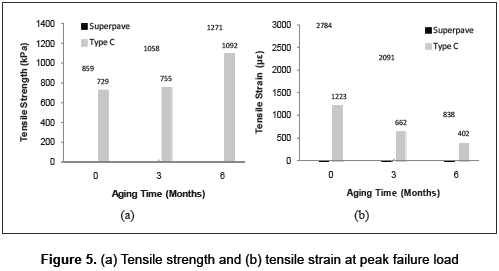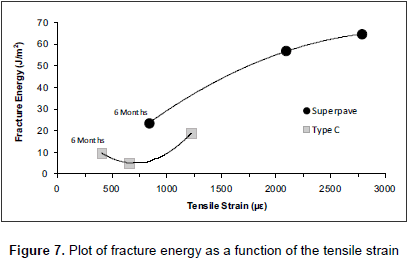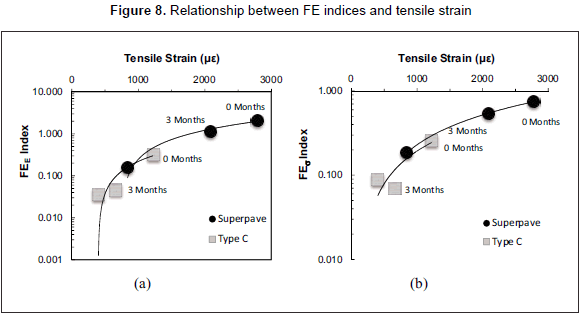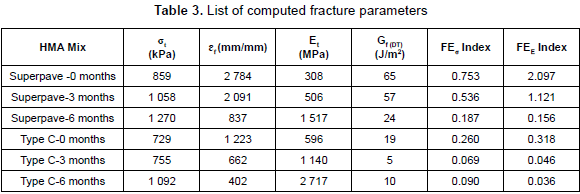Serviços Personalizados
Journal
Artigo
Indicadores
-
 Citado por SciELO
Citado por SciELO -
 Acessos
Acessos
Links relacionados
-
 Citado por Google
Citado por Google -
 Similares em
SciELO
Similares em
SciELO -
 Similares em Google
Similares em Google
Compartilhar
Revista EIA
versão impressa ISSN 1794-1237versão On-line ISSN 2463-0950
Rev.EIA.Esc.Ing.Antioq n.17 Envigado jan./jun. 2012
EVALUATION OF HMA CRACKING RESISTANCE AS A FUNCTION OF LABORATORY AGING BASED ON THE DIRECT-TENSION TEST
EVALUACIÓN DE LA RESISTENCIA AL AGRIETAMIENTO DE MEZCLAS ASFÁLTICAS EN CALIENTE EN FUNCIÓN DE SU ENVEJECIMIENTO A PARTIR DEL ENSAYO DE TENSIÓN DIRECTA
AVALIAÇÃO DA RESISTÊNCIA AS RACHADURAS DE MISTURAS ASFÁLTICAS EM QUENTE EM FUNÇÃO DE SEU ENVELHECIMENTO A PARTIR DO ENSAIO DE TENSÃO DIRETA
Lubinda F. Walubita*, Blanca L. Flórez**, Allex E. Álvarez***
*Civil Engineer, University of Zambia; M.Sc., Universidad de Stellenbosch; Ph.D., Texas A and M University. Researcher, Texas Transportation Institute-TTI, The Texas A and M University System. College Station, TX, USA. l-walubita@ttimail.tamu.edu.
**Ingeniera Civil y Miembro del Grupo Integrado de Investigación en Ingeniería Civil (GIIC), Universidad del Magdalena. Santa Marta, Colombia. elvica-25@hotmail.com.
***Ingeniero Civil, Universidad Nacional de Colombia; M.Sc., Universidad de los Andes, Bogotá; Ph.D., Texas A and M University. Profesor Asociado y Director del Grupo Integrado de Investigación en Ingeniería Civil (GIIC), Universidad del Magdalena. Santa Marta, Colombia. aalvarez@unimagdalena.edu.co.
Artículo recibido 31-VIII-2011. Aprobado 19-VI-2012
Discusión abierta hasta diciembre de 2012
ABSTRACT
Hot mix asphalt (HMA) is a heterogeneous composite material of asphalt-binder, aggregates, air voids, and other additives including lime, fibers, etc., predominantly used for pavement construction. With time, the HMA mix ages, which leads to changes in the material properties and response behavior. This paper documents a laboratory study that was conducted to evaluate the suitability of the direct-tension (DT) test to assess the effects of asphalt-binder aging on the HMA mix fracture properties and cracking-resistance potential. Two dense-graded HMA mixes were subjected to different laboratory aging exposure conditions and then tested with the DT test. From this test, the HMA mix fracture response was characterized in terms of the tensile strength, tensile strain at peak failure load, stiffness, and fracture energy. Overall, the results indicated that asphalt-binder aging has a detrimental effect on the fracture response and cracking-resistance of HMA mixes, which can be captured based on the DT test. Therefore, the asphalt-binder aging needs to be considered and properly accounted for during the material design and analysis stages of HMA mixes. However, research with more HMA mixes and correlation with field data is strongly recommended to validate the laboratory findings reported in this paper.
KEY WORDS: asphalt-binder; hot mix asphalt (HMA); aging; fracture; cracking.
RESUMEN
La mezcla asfáltica en caliente (MAC) es un material compuesto, heterogéneo, integrado por cemento asfáltico (o asfalto), agregados, vacíos y otros aditivos incluyendo cal, fibras, etc., usado predominantemente para la construcción de pavimentos. A lo largo del tiempo, la MAC sufre envejecimiento, lo cual conlleva cambios en las propiedades del material y en su respuesta. Este artículo documenta un estudio de laboratorio llevado a cabo para evaluar la posibilidad de emplear el ensayo de tensión directa (TD) para determinar los efectos del envejecimiento del asfalto sobre las propiedades de fractura y resistencia al agrietamiento de MAC. Dos MAC de gradación densa fueron sometidas a diferentes condiciones de envejecimiento en laboratorio y luego sometidas al ensayo de TD. A partir de este ensayo, el comportamiento ante fractura se caracterizó en términos de la resistencia a tensión, deformación unitaria de tensión a la carga de falla, rigidez y energía de fractura. En general, los resultados indicaron que el envejecimiento por oxidación del asfalto tiene un efecto negativo sobre la respuesta ante fractura y la resistencia al agrietamiento de la MAC, el cual puede ser captado por medio del ensayo de TD. Por lo tanto, el envejecimiento del asfalto debe ser considerado y cuantificado en forma adecuada durante el diseño y análisis de la MAC. Sin embargo, se recomienda adelantar investigación adicional con otras mezclas y correlacionar resultados con datos de campo para validar la información de laboratorio reportada en este artículo.
PALABRAS CLAVE: cemento asfáltico; mezcla asfáltica en caliente; envejecimiento; fractura; agrietamiento.
RESUMO
A mistura asfáltica em quente (MAQ) é um material composto, heterogéneo, integrado por cimento asfáltico (ou asfalto), agregados, vazios e outros aditivos incluindo cal, fibras, etc., usado predominantemente para a construção de pavimentos. Ao longo do tempo, a MAC sofre envelhecimento, o qual implica mudanças nas propriedades do material e em sua resposta. Este artigo documenta um estudo de laboratório levado a cabo para avaliar a possibilidade de empregar o ensaio de tensão direta (TD) para determinar os efeitos do envelhecimento do asfalto sobre as propriedades de fratura e resistência à rachadura de MAC. Dois MAC de gradação densa foram submetidas a diferentes condições de envelhecimento em laboratório e depois submetidas ao ensaio de TD. A partir deste ensaio, o comportamento à fratura caracterizou-se em termos da resistência a tensão, deformação unitária de tensão à carga de falha, rigidez e energia de fratura. Em geral, os resultados indicaram que o envelhecimento por oxidação do asfalto tem um efeito negativo sobre a resposta à fratura e a resistência à rachadura da MAC, o qual pode ser captado através do ensaio de TD. Portanto, o envelhecimento do asfalto deve ser considerado e quantificado em forma adequada durante o desenho e análise da MAC. No entanto, recomenda-se fazer pesquisa adicional com outras misturas e correlacionar resultados com dados de campo para validar a informação de laboratório reportada em este artigo.
PALAVRAS-CÓDIGO: cimento asfáltico; mistura asfáltica em quente; envelhecimento; fratura; rachadura.
1. INTRODUCTION
Hot-mix asphalt (HMA) mix is a heterogeneous complex composite material of air, asphalt-binder, aggregate, and other additives such as lime, cellulose fiber, etc., predominantly used for road pavement construction. Under traffic loading and changing environmental conditions, the HMA mix exhibit non-linear viscoelastic-viscoplastic and anisotropic behavior (Walubita, 2006; Huang et al., 2011). With time, the HMA mix, and ultimately the asphalt-binder in it also ages, but with the potential to heal (closure of micro-fractured or micro-cracked surfaces) during traffic loading rest periods (Kim, 2009).
As noted above, the asphalt-binder within the HMA generally experiences aging with time and under changing environmental conditions, a process that often involves chemical and structural changes in the material (Vargas and Reyes, 2010). The aging phenomenon starts with the HMA mix fabrication process -short term aging- and progresses in the field along the pavement service life -long term aging-. Besides the original chemical composition and properties of the asphalt-binder, several aspects define the field rate of aging in the HMA mix. These aspects can include, for example, the HMA mix air void content (Glover et al., 2005), asphalt-binder film thickness coating the aggregate particles (Kandhal and Chakraborty, 1996), fabrication temperature of the HMA mix, and temperature conditions where the HMA mix performs (Glover et al., 2005).
The changes occurring in the asphalt-binder due to aging lead to changes in the engineering properties as well -rheological (Lu and Isacsson, 2002), mechanical (Airey, 2003), and thermodynamic (Kim, 2009)- of the asphalt-binder and, therefore, of the corresponding HMA mix. Previous research reported that aging increased the HMA mix stiffness and reduced its ductility potential, thus increasing the HMA mix's brittleness and susceptibility to fracture damage and cracking (Glover et al., 2005). The susceptibility to moisture damage may also be altered or even worsened as the asphalt-binder ages in the HMA mix (Punith et al., 2012).
In addition, according to Jung (2006), asphaltbinder aging is very critical in the top portion of surface HMA layers due to direct environmental exposure and generally decreases with depth. The net result is often stiffer and brittle or "dry" HMA layers that are susceptible to fracture damage and cracking. In fact, one of the predominant causer of top-down cracking in HMA pavements is hypothesized to be asphalt-binder aging, resulting in high thermal stresses in the HMA mix (PI, 2011). Aging also has a tendency to reduce the cohesiveness, adhesiveness, and bonding properties of the asphalt-binder, thus exacerbating other distresses such as fatigue, moisture damage, etc., which can promote potholing and, in general, cause loss of durability. Some examples of age-related HMA pavement damage are shown in figure 1.
Without doubt, these distresses are undesired and a financial drain on the highway agencies in terms of maintenance and rehabilitation activities. Therefore, there is still a need to fully understand the effects of asphalt-binder aging on the HMA mix fracture parameters and cracking resistance potential; and how this could be incorporated in design models (i.e., including laboratory testing) so as to minimize aging related damage and optimize the HMA mix performance.
Based on the above background, the main goal of this paper was to evaluate the suitability of the direct-tension (DT) test to assess the effects of asphalt-binder aging on the HMA mix fracture properties and cracking-resistance potential. The research methodology incorporated evaluation of HMA mix specimens subjected to aging for 0, 3, and 6 months in the laboratory. Two dense-graded mixes were subjected to DT testing to characterize and measure the following fracture parameters in response to asphalt-binder aging:
- HMA mix tensile strength
- HMA mix ductility potential based on the tensile strain at peak failure load
- HMA mix elastic tensile stiffness (or tensile modulus)
- HMA mix fracture energy and associated indices
With the above objectives, it should be emphasized here that direct measurement of the actual degree, extent, and/or quantification of aging was outside the scope of this study; these details are documented elsewhere (Glover et al., 2005; Jung, 2006). The primary focus was to assess how the HMA fracture properties, as measured with the DT test, changed and varied as a function of the specified aging period in the laboratory. Secondly, the intent was to concurrently evaluate if the DT test was sensitive enough and able to sufficiently capture the changes in the HMA fracture properties in response to the specified laboratory aging conditions.
In terms of the paper layout, following this introduction is a brief discussion of the kinetics of asphalt-binder aging, followed by a description of the DT test protocol, data analysis models for computing the fracture parameters, and the experimental design plan. Results are then presented and analyzed, followed by a summary of key findings and recommendations to conclude the paper.
2. THEORY AND KINETICS OF ASPHALT-BINDER AGING
Asphalt-binder can simplistically be defined as a dark-brown to black viscous-cementitious compound, predominantly composed -as hypothesized in the classical asphalt chemistry model- of hydrocarbons that are associated in two main fractional components termed as asphaltenes and maltenes (Pfeiffer and Saal, 1940; Arenas, 2005). Asphaltenes are the polar, high molecular weight, and less soluble hydrocarbons that constitute about 5 to 25 % by total weight of the asphalt-binder. The maltenes, on the other hand, are non-polar or relatively low polar, lower molecular weight, and soluble hydrocarbons (Asphalt Rehab, 2012).
At a microstructural level, asphalt-binder is thus defined as a suspended polar fluid of a continuous three-dimensional association of polar molecules (asphaltenes) suspended in a fluid of non-polar or relatively low-polarity molecules (maltenes), i.e., colloids of asphaltene micelles suspended in maltenes (Lin et al., 1996). The adhesion of asphalt-binder to aggregate is also thought to depend on the polar attraction between molecules in the asphalt-binder and the polar surfaces of the aggregates.
2.1 Asphalt-binder aging and embrittlement
During aging, the asphalt-binders lose some of its volatile lower molecular weight constituents to form carbonyl (- C=O) groups that increase the polarity of their host compounds. As aging progresses and carbonyl associations are formed, less soluble asphaltene materials, which behave like solid particles, are created ( Liu et al., 1998; Jung, 2006). This composition change increases the asphalt-binder's viscosity and elastic properties, i.e., the asphaltbinder loses its viscoelastic and plasticity properties.
Thus, the aged asphalt-binder sustains shear stress with deformation (high elastic stiffness) and simultaneously, the material cannot relieve the stress by flow (high viscosity), resulting in asphalt-binder age-hardening and embrittlement with time. Detailed chemistry of the asphalt-binder composition and chemical kinetics (aging) can be found elsewhere (Domke, Davison and Glover, 2000; Glover et al., 2005; Jung, 2006).
2.2 Asphalt-binder aging and HMA mixes
In HMA mixes, asphalt-binder is predominantly used as a cementitious-bonding material between the aggregate particles. It is also used as an HMA waterproofing material. In fact, the HMA pavement construction industry uses approximately 85 % of the asphalt-binders produced worldwide; with the asphalt-binder constituting about 4 to 8 % by weight of the total HMA mix and contributing about 30 % to the total cost of HMA pavement structures (Jung, 2006).
The oxidative and polarity state of the asphaltbinder at any given time has a significant bearing on the chemical, mechanical, and physical properties of HMA mix, and ultimately, the HMA mix performance and durability. Due to aging (i.e., increase in polarity) and changing environmental conditions, the asphaltbinder age-hardens (stiffens), becomes more brittle, and loses its viscoelastic properties (Jung, 2006). These changes impact the HMA mix fracture properties and cracking-resistance potential and increase the susceptibility of HMA mix to moisture damage (stripping) and potholing. This change in moisture susceptibility is because aged asphalt-binders have a larger number of polar constituents that are more prone to attracting water molecules; and thus, ease breakage of the bonding with aggregates (Glover et al., 2005; Jung, 2006).
3. THE DIRECT-TENSION (DT) TEST PROTOCOL
In this study, the uniaxial DT test was used to measure the fracture parameters (tensile strength, strain, tensile modulus, and fracture energy) as a means to characterize and evaluate the ductility and cracking resistance potential of HMA mixes in response to aging. The DT test parameters consisted of a continuous axial tensile load applied at a displacement rate of 1.27 mm/min (Walubita, 2006). Under this testing condition, the test took at most 5 minutes. Figure 1 shows the laboratory test set-up and loading configuration for the DT test conducted in this study (Walubita, Simate and Oh, 2010).
The DT test was conducted at 20 °C with a minimum temperature pre-conditioning time of 2 hours. This temperature was monitored via a thermocouple probe attached inside a dummy HMA mix specimen also placed in the same environmental-temperature chamber as the test specimens.
4. DT TEST DATA AND ANALYSIS MODELS
Based on the DT test output data, the HMA mix tensile strength (σt) in MPa, tensile strain at the peak failure load (εf) in mm/mm, tensile modulus (Et) in MPa, fracture energy (Gf(DT)) in J/m2, and fracture energy indices (FEσ Index and FEE Index), were calculated using equation 1 through 6, respectively.
where Pmax is the maximum tensile load at failure (kN) (or peak failure load, which defines the "failure condition" or break point of the specimen under DT testing); r is the specimen radius (mm), i.e., 50 mm in this case; ΔL is the maximum elongation at Pmax (mm); and L0 is the initial centre-to-centre distance between the linear variable displacement transducers (LVDTs) (mm), which was 100 mm in this study (figure 2) (Walubita, 2006; Walubita, Simate and Oh, 2010).
Based on equation 4, the total fracture energy (energy required to fracture the HMA mix specimen) is represented by the area under the load versus displacement curve (i.e., area between the integral limits x1 and x2 in the figure 2). In this study, the fracture energy was computed only up to the point of peak failure load that corresponds to part "A" in figure 2, since the DT tests were terminated at the instance of 50 % drop in the peak failure load. Corresponding computations of fracture energy were conducted using the MATLAB (MathWorks, 2011) routine software.
5. EXPERIMENTAL DESIGN PLAN
Two dense-graded HMA mixes that are commonly used in Texas (USA) were evaluated in this study. Corresponding mix design characteristics are listed in table 1 and the aggregate gradations are comparatively shown in figure 3 (Walubita, 2006).
The two HMA mixes listed in table 2 were designed in the laboratory based on the Texas gyratory compactor and Superpave mix-design methods (TxDOT, 2011). As shown in the figure 2, the DT test specimens are cylindrically shaped with dimensions of 50 mm radius by 150 mm in height; giratory molded to a target total air void content of 7±0.5 % (Walubita, 2006; TxDOT, 2011) to simulate the field air void content after construction and trafficking when fatigue-cracking-resistance is considered critical.
As recommended in previous research (Walubita et al., 2012), these DT specimens are typically cored from 75 mm in radius samples of higher height (i.e., height > 150 mm) to improve the homogeneity of the air void distribution (i.e., homogeneity of the mix internal structure). A minimum of three replicate specimens were tested for each HMA mix type per laboratory aging condition and the results subsequently presented correspond to the mean computed based on the three replicates. In total, a minimum of 18 HMA mix samples were molded and tested.
In order to investigate the suitability of the DT test to assess the effects of asphalt-binder aging on the HMA mix fracture parameters and crackingresistance potential, HMA mix specimens were exposed to accelerated laboratory aging prior to DT testing. Three aging exposure conditions (i.e., 0, 3, and 6 months at 60 °C), that simulate different Texas field HMA pavement aging at the critical pavement service temperature based on a study by Glover et al. (2005), were used.
The accelerated aging process of the HMA mix specimens involved keeping them in a temperaturecontrolled room at 60 °C and allowing heated air to circulate freely around the specimens. Previous research showed that aging of the asphalt-binder within the HMA specimens occurred under these laboratory aging conditions (Glover et al., 2005). Note that all the loose HMA mixes were subjected to the standard 4 hour short-term oven aging (STOA) process at 135 °C consistent with the AASHTO PP2 (1994) procedure for Superpave mix performance testing prior to HMA mix specimen compaction and the stated 60 °C accelerated aging process. Table 2 summarizes the laboratory aging processes along with the corresponding references.
6. RESULTS AND ANALYSES
This section presents the results and corresponding analyses of the laboratory aging effects on the HMA mix response evaluated in terms of the fracture parameters computed based on the DT test data. The first subsection focuses on the analysis of the tensile strength, tensile strain, and tensile modulus, followed by analysis of the fracture energy and the associated indices. It should be noted that these results pertain only to the HMA mixes, DT test conditions, and laboratory aging conditions defined in this study. Therefore, the overall findings and conclusions may not be exhaustive.
6.1 Analysis of tensile strength, tensile strain, and tensile modulus
Figure 4 shows the stress-strain response of the HMA mixes as a function of the three different aging exposure conditions, namely 0, 3, and 6 months. Overall, the stress-strain response of the mixes is consistent with theoretical expectations and supports the preceding discussions about asphalt-binder aging and embrittlement.
As aforementioned, the changes in the asphaltbinder chemistry and kinetic composition due to aging leads to age-hardening and embrittlement that, as evident in figure 4, has a significant impact on the HMA mix stress-strain response and, consequently, the cracking resistance potential of the HMA mixes. As stated in the introduction, however, quantifying and/or evaluating the actual changes in the chemistry and kinetic composition of the asphalt-binder or degree of oxidation due to aging were beyond the scope of this study.
Figure 5 shows the values of the tensile strength and tensile strain at peak failure load for the HMA mixes evaluated (table 2). In this study, the tensile strength was adapted as an indicator of the ultimate tensile load capacity for the HMA mix and the tensile strain at peak failure load was adapted as an indicator of the HMA mix ductility potential, which basically defines the HMA mix's potential to elongate under tensile stress prior to breakage. Therefore, desirable ductile mixes are associated with high values of tensile strain at peak failure load and vice versa for brittle mixes.
In previous research, Walubita et al. (2010) suggested discrimination of cracking resistant and not cracking resistant HMA mixes based on a threshold value of 3000 µe for the tensile strain at failure; i. e., εf ≥ 3000 µε is related to cracking resistant mixes under the discussed DT test protocol. This laboratory criterion exhibited potential to discriminate the cracking resistance of HMA mixes that also closely correlated with the observed field performance of the majority of the HMA mixes evaluated by Walubita (2006). Based on this previous research and Figure 4. Comparison of HMA mix stress-strain responses taking due cognizance of the fact that the tensile strain at failure does not really constitute a fundamental quantification of HMA mix ductility, this fracture parameter was nonetheless adapted as an indicator of the HMA mix ductility potential for easy comparison of the mixes.
Based on the previously discussed concepts in this paper, the data shown in figure 5 provide evidence of changes in the HMA mix fracture response due to aging. For the mixes evaluated, the tensile strength increased with aging time. In addition, both mixes also did not meet the ductility criterion of εf ≥ 3000 µε at zero-month aging exposure condition. In fact, these mixes are classified as moderately crack resistant based on previous research studies and actual field performance on Texas (USA) roads (TxDOT, 2004; Walubita and Scullion, 2008; Walubita, Simate and Oh, 2010). Despite this observation, the aging effect -reduction of the mix ductility as evaluated in terms of lower tensile strain values- were consistently manifested in the mix response and were sufficiently captured by the DT test (figure 5b).
Compared to the tensile strength, the reduction of the tensile strain values is quite substantial with a likelihood of expecting similar changes in the HMA mix ductility and cracking resistance potential. For instance, while the changes in both parameters were almost similar (approximately 24 %) at 3 months of aging exposure, the tensile strain had decreased by 70 % in the 6th month, while the incremental change in the tensile strength was only 48 %. Conclusively, these results indicate that the tensile strain parameter is more sensitive to aging than that of the tensile strength. Between the two, the tensile strain at peak failure load would, therefore, be the best fracture parameter to use to evaluate the effects of aging on HMA mixes under DT testing. This conclusion is also consistent with previous research findings on un-aged HMA mixes from the authors.
Figure 6 shows the computed HMA mix tensile modulus (i.e., secant modulus) as a function of the three laboratory aging exposure conditions, namely 0, 3, and 6 months at 60 °C. As theoretically expected and consistent with the preceding theory on age-hardening and embrittlement (Jung, 2006), these DT test results indicate that the HMA mix stiffness increases as aging progresses. The final stiffness computed after 6 months of laboratory aging -simulating the aging induced by approximately 6 to 12 years of Texas HMA mix environmental exposure (Glover et al., 2005)- is more than five times higher in magnitude than the stiffness computed for the same mix evaluated just after laboratory compaction (i.e., 0 months) -simulating the HMA mix aging condition just after in situ field compaction (Glover et al., 2005)-. That is the HMA mix stiffness had increased by over 100 % by the 6th month of laboratory aging.
Compared to the tensile strain (figure 5), figure 6 shows that the tensile modulus is comparatively more sensitive to aging. By the 6th month of laboratory aging, for instance, the change in the tensile modulus for both mixes was about 5 times to the corresponding value computed at 0 months aging, while it was only 3 times for the tensile strain. Between the two fracture parameters, however, the tensile strain would be preferred as it is directly related to HMA ductility potential and also, as reported in previous publications (Walubita, 2006; Walubita et al., 2010), it exhibited better correlation with field cracking performance.
In terms of the particular HMA mix response, the Superpave mix showed to be more ductile, less stiff, and exhibited higher ultimate tensile load capacity than the Type C mix. The higher AC content, higher asphalt-binder PG grade, and modification with an SBS polymer along with the use of hydrated lime (table 1) can partially explain the better ductility response of the Superpave mix. Since the aggregate gradation did not differ significantly, another factor leading to the superiority of the Superpave mix could be the better quality aggregate type (gravel) used, which is non-absorptive. Most Central Texas limestone aggregates are known to be highly absorptive with a high potential to reduce the net effective asphalt-binder content, which has a negative effect on the HMA mix fracture properties and cracking resistance potential (Walubita et al., 2010). All these factors may have impacted these results, but were outside the scope of this study.
In summary, analysis of the fracture parameters computed based on the DT test data sufficiently reflected the effects of aging on the HMA mix response and is consistent with theoretical expectations. Overall, the tensile strain would be the preferred fracture parameter to characterize the HMA mix cracking resistance potential as a function of aging. For the fracture parameters shown in figure 4 through 6 and looking at their changes in magnitude as a function of the laboratory aging conditioning process applied, the Type C mix appears to be more sensitivity to aging than the particular Superpave mix evaluated and would theoretically expected to be more susceptible to age-related fracture damage and cracking. Between the two particular mixes evaluated, and assuming similar field conditions, the Superpave would thus be preferred over the Type C mix.
6.2 Analysis of fracture energy and fracture energy indices
The computed fracture energy (FE) and associated indices are plotted in figures 7 and 8, respectively, as a function of the tensile strain at peak failure load and the laboratory aging exposure conditions. Note that in addition to the FE and the preceding fracture parameters discussed in Section 6.1, the FE Index was also explored as a novel concept to gauge if it provided superior and effective differentiating capabilities in terms of capturing the HMA mix fracture response to laboratory aging under DT testing. For the purpose of this study, the FE Index was devised and defined as a parametric ratio that quantifies the amount of fracture energy required to induce damage relative to the HMA tensile strength and/or stiffness. Mathematically and as indicated in equations 5 and 6, the FE Index is computed as a ratio of the FE to the HMA mix tensile strength and/or stiffness.
With the exception of the 3-month data for the Type C mix, the fracture energy generally exhibits a decreasing trend with aging as theoretically expected, implying that as the asphalt-binder losses its cohesive/adhesive and bonding properties due to aging, less energy is required to induce fracture damage and/or cracking. Theoretically, higher fracture energy values denote better resistance to fracture damage and cracking for the HMA mix. Therefore, aging is an undesired phenomenon in the HMA mixes.
Like figure 4 through 6, both figures 7 and 8 seem to suggest that the Type C mix, as compared to the Superpave mix, is more susceptible to fracture damage and cracking based on the smaller magnitudes of the FE parameters at all levels of aging. That is, if all other factors are equal, less energy would be required to cause fracture damage in the Type C mix compared to the Superpave mix; it is an aspect which can be tied to the mix-design characteristics listed in table 1. In the case of figure 7, however, the opposite would be concluded if the interpretation of the data is purely based on the slopes of graphs. Thus, the need to focus on the FE Indices that show a more consistent and distinctive response trend, particularly the FEE Index. Furthermore, although the Type C mix exhibits an unexplained characteristic response at 3 months aging, the general trend of the fracture energy is nonetheless clearly evident; it is decreasing as a function of laboratory aging time, e.g., Type C-0 months versus Type C-6 months.
Looking at figure 8 and considering the fitted trend lines, it is clear that the FEE Index provides a more distinctive and consistent differentiation of the HMA mix response as a function of both aging condition and tensile strain at peak failure load. Theoretically, this may be attributed to the fact the FEE Index represents a combination of all the HMA mix fracture parameters (namely FE, st, and et) and thereby, capturing the complete fracture response of the HMA mix under DT testing. Therefore, the FEE Index would be preliminarily recommended at this stage as the suitable fracture parameter to assess the cracking resistance potential of HMA mixes as a function of laboratory aging under DT testing. However, additional research is still required to validate these results and suggest a final recommendation for future HMA mix characterization.
Table 3 is a comparative listing of all the fracture parameters computed as a function of aging and provides additional evidence that the Superpave mix has superior fracture response than the Type C mix. Other than the tensile modulus, all the fracture parameters for the Superpave mix are desirably higher in magnitude than the Type C mix at all laboratory aging conditions.
The higher tensile modulus values of the Type C mix suggests that this mix is relatively stiffer and more brittle (less ductile) than the Superpave mix. As noted in table 3, this poor ductility potential means that the mix sustains lower tensile strains prior to failure and that relatively lower fracture energy is expanded to induce this damage. As theoretically expected, the cracking resistance potential, as measured by the changes in the fracture parameters listed in table 3, seems to deteriorate with aging time for both mixes; with this particular Type C mix (i.e., asphalt-aggregate combination) exhibiting more sensitivity to aging.
6.3 Statistical analysis
In terms of statistical variability of the DT data, the COV for st ranged from 2 % to 7 %, while the COV range was from 4 % to 18 % for the εf and Et parameters. In general, higher COV values were measured for the Superpave mix samples at all laboratory aging conditions, presumably due to poor workability problems in the laboratory attributed to the stiffer asphalt-binder due to the SBS modifier (Walubita, 2006). Parameter wise, statistical variability was least in the computation of σt and more scattered for the εf parameter. Assuming a COV threshold of 30 % (Walubita et al., 2010), these statistics are, therefore, considered reasonably acceptable to statistically substantiate the above results and findings.
Likewise, the COV values for both the FE and FE Indices exhibited a similar trend and were all less than 30 % in magnitude. However, they were slightly higher than the preceding fracture parameters, ranging from 12 % to 29 %. Nonetheless, the COV values were still considered reasonable (i.e., less than 30 %) and thus, further substantiating the statistical validity of the results and findings presented.
7. CONCLUSIONS AND RECOMMENDATIONS
This paper documented a laboratory study that was conducted to evaluate the suitability of the direct-tension (DT) test to assess the effects of asphalt-binder aging on the HMA mix fracture properties and cracking-resistance potential. Two dense-graded HMA mixes with different mix-design characteristics were subjected to three laboratory aging exposure conditions (0, 3, and 6 months at 60 °C) and then, tested in the DT test to measure the following fracture parameters: tensile strength, tensile strain at peak failure load, tensile modulus, fracture energy, and fracture indices. Analysis of these fracture parameters as a function of aging yielded the following conclusions:
- Through measurement and computation of the fracture parameters evaluated, this study suggests that the DT test (i.e., at 1.27 mm/min load rate and 20 °C) can successfully be used to characterize and capture the HMA mix sensitivity to asphalt-binder aging in the laboratory.
- Of the HMA fracture parameters evaluated based on the DT test, the tensile strain at peak failure load and the FEE Index exhibited the best potential to capture the effects of aging on the HMA mix fracture response. Therefore, these parameters (in particular the FEE Index) should be explored further as a means to characterize the HMA mix fracture response and sensitivity to asphalt-binder aging under DT testing.
- As a function of aging, the HMA mixes exhibited the following responses under DT testing: (1) the tensile strength and tensile modulus increased, (2) the tensile strain at peak failure load decreased, and (3) despite one outlier, the fracture energy required to induce damage generally exhibited a decreasing trend. This means that the HMA mixes become more susceptible to fracture damage with aging time, which among other factors can theoretically be attributed to progressive loss of adhesive/cohesive and bonding properties as well as changes in the rheological properties of the asphalt-binder.
- Due to the differences in the mix-design variables of the two particular HMA mixes tested, the HMA mix response to asphalt-binder aging was different, with the Superpave mix exhibiting superior fracture properties and cracking resistance potential at all aging conditions. Thus, adequate mix-design (i.e., including proper selection of the asphalt-aggregate combination) is one aspect to optimize the HMA mix resistance to age-related fracture damage and cracking.
Overall, this study has demonstrated that aging is detrimental to the HMA mix fracture properties and obviously, cracking performance; and that different HMA mixes respond differently to asphalt-binder aging. In addition to premature fracture damage and cracking, potholing and loss of durability are other distresses likely to be exacerbated by asphalt-binder aging. Therefore, consideration should be undertaken to sufficiently incorporate aging in HMA mix designs and performance prediction models. Development of new generation mix-design methods and aging shift factors to account for asphalt-binder aging are some of the options to consider. Lastly, additional research is recommended to validate the findings of this study along with more HMA mixes and correlations with field performance data.
8. ACKNOWLEDGEMENTS
This study was conducted as part of TxDOT and the Federal Highway Administration (FHWA) sponsored research projects to evaluate different laboratory HMA mix crack test methods including effects of aging. The authors grateful acknowledge and thank TxDOT and FHWA for the financial support. The authors also thank all those who rendered help towards the completion of this study as well as the paper, particularly Gautam Das, Lee Gustavus, Tony Barbosa, Geoffrey S. Simate (Wits University, South Africa), Charles Mushota (Estal Pride (Z) Ltd., Zambia), and Tom Scullion (TTI) for their invaluable contributions to this study as the paper itself. The third author, as Associate Professor of the University of Magdalena (Colombia), expresses special thanks to this institution for the support received to complete this work. Lastly, the primary author also acknowledges the assistance received from the Wuhan Institute of Technology (China), where he serves as a Visiting Professor.
9. DISCLAIMER
The contents of this paper reflect the views of the authors who are solely responsible for the facts and accuracy of the data presented herein and do not necessarily reflect the official views or policies of any agency or institute. This paper does not constitute a standard, specification, nor is it intended for design, construction, bidding, contracting, tendering, or permit purposes. Trade names were used solely for information purposes and not for product endorsement.
REFERENCES
AASHTO. Standard specifications for transportation materials and methods of sampling and testing. Designation: PP2, Standard practice for short and long term aging of hot mix asphalt. Washington D.C., 1994. [ Links ]
Airey, G. D. (2003). "State of the art report on ageing test methods for bituminous pavement materials". International Journal of Pavement Engineering, vol. 4, No. 3, pp. 165-176. [ Links ]
Arenas, H. L. Tecnología del cemento asfáltico. Popayán: Faid, 2005. [ Links ]
Asphalt Rehab: (consulted on June 11, 2012) Available in: <http://www.asphaltrehab.com/infrared.html>. [ Links ]
Domke, C. H.; Davison, R. R. and Glover, C. J. (2000). "Effect of oxygen pressure on asphalt oxidation kinetics". Industrial and Engineering Chemistry Research, vol. 39, No. 3, pp. 592-598. [ Links ]
Glover, C. j.; Davison, R. R.; Domke, C.; Ruan, Y.; Juristyarini, P.; Knorr, D. and Jung, S. H. Development of a new method for assessing asphalt binder durability with field validation. Report No. FHWA/TX-05/1872-2. College Station, TX: Texas Transportation Institute / Texas A and M University, 2005. [ Links ]
Huang, C.; Abu Al-Rub, R.; Masad, E.; Little, D. and Airey, G. (2011). "Numerical implementation and validation of a nonlinear viscoelastic and viscoplastic model for asphalt mixes". International Journal of Pavement Engineering, vol. 12, No 4, pp. 433-447. [ Links ]
Jung, S. F. The effects of asphalt binder oxidation on hot mix asphalt concrete mixture rheology and fatigue performance. Ph.D. Dissertation (Chemical Engineering), Texas A and M University, College Station, TX, 2006. [ Links ]
Kandhal, P. S. and Chakraborty, S. (1996). "Effect of asphalt film thickness on short- and long-term aging of asphalt paving mixtures". Transportation Research Record, No. 1535, pp. 83-90. [ Links ]
Kim, R. Y. Modeling of asphalt concrete. New York: McGraw-Hill, 2009. [ Links ]
Lin, M.-S.; Chaffin, J. M.; Liu, M.; Glover, C. J.; Davison, R. R. and Bullin, J. A. (1996). The effect of asphalt composition on the formation of asphaltenes and their contribution to asphalt viscosity. International Symposium on the Thermodynamics of Heavy Oils and Asphaltenes, Houston, TX (20 March 1995), vol. 14, No. 1-2, pp. 139-162. [ Links ]
Liu, M. M.; Lin, M. S.; Chaffin, J. M.; Davison, R. R.; Glover, C. J. and Bullin, J. A. (1998). "Oxidation kinetics of asphalt Corbett fractions and compositional dependence of asphalt oxidation". Petroleum Science and Technology, vol. 16, No. 7-8, pp. 827-850. [ Links ]
Lu, X. and Isacsson, U. (2002). "Effect of ageing on bitumen chemistry and rheology". Construction and Building Materials, vol. 16, No. 1 (February), pp. 15-22. [ Links ]
MathWorks. MATLAB. Natick, Massachusetts, USA, 2011. [ Links ]
Pavement Interactive (PI). (consulted on July 8, 2011) Available at: <http://pavementinteractive.org/index.php?title=Top-Down_Cracking>. [ Links ]
Pfeiffer, J. P. and Saal, R. N. J. (1940). "Asphaltic bitumen as colloid system". The Journal of Physical Chemistry, vol. 44, No. 2, pp. 139-149. [ Links ]
Punith, V. S.; Xiao, F.; Putman, B. and Amirkhanian, S. N. (2012). "Effects of long-term aging on moisture sensitivity of foamed WMA mixtures containing moist aggregates". Materials and Structures, vol. 45, pp. 251-264. [ Links ]
TxDOT Standard specifications for construction and maintenance of highways, streets, and bridges. Austin, TX, 2004. [ Links ]
TxDOT. TxDot online manuals (consulted on July 2, 2011) Available in: <http://www.dot.state.tx.us/services/general_services/manuals.htm>. [ Links ]
Vargas, X. and Reyes, F. (2010). "Asphalt's aging phenomenon". Ingeniería e Investigación, vol. 30, No. 3, pp. 27-44. [ Links ]
Walubita, L. F. Comparison of fatigue analysis approaches for predicting fatigue lives of hot-mix asphalt concrete (HMAC) mixtures. PhD Dissertation, Texas A and M University, College Station, TX, 2006. [ Links ]
Walubita, L. F.; Jamison, B.; Alvarez, A. E.; Hu, X. and Mushota, C. (2012). "Air void characterisation of HMA gyratory laboratory-moulded samples and field cores using X-ray computed tomography (X-ray ct)". Journal of the South African Institution of Civil Engineering, vol. 54, No. 1 (April), pp. 22-31. [ Links ]
Walubita, L. F. and Scullion, T. Thin HMA overlays in Texas: Mix-design and laboratory material property characterization. Research Report No 0-5598-1. Texas Transportation Institute-Texas A and M University, College Station, TX, 2008. [ Links ]
Walubita, L. F.; Simate, G. S. and Oh, J. (2010). "Characterising the ductility and fatigue crack resistance potential of asphalt mixes based on the laboratory direct tensile strength test". Journal of the South African Institution of Civil Engineering, vol. 52, No. 2, pp. 31-40. [ Links ]
Walubita, L. F.; Umashankar, V.; Hu, X.; Jamison, B.; Zhou, F.; Scullion, T.; Epps Martin, A. and Dessouky, S. New generation mix-designs: Laboratory testing and construction of the apt test sections. Report 0-6132-1. Texas Transportation Institute-Texas A and M University, College Station, TX, 2010. [ Links ]













